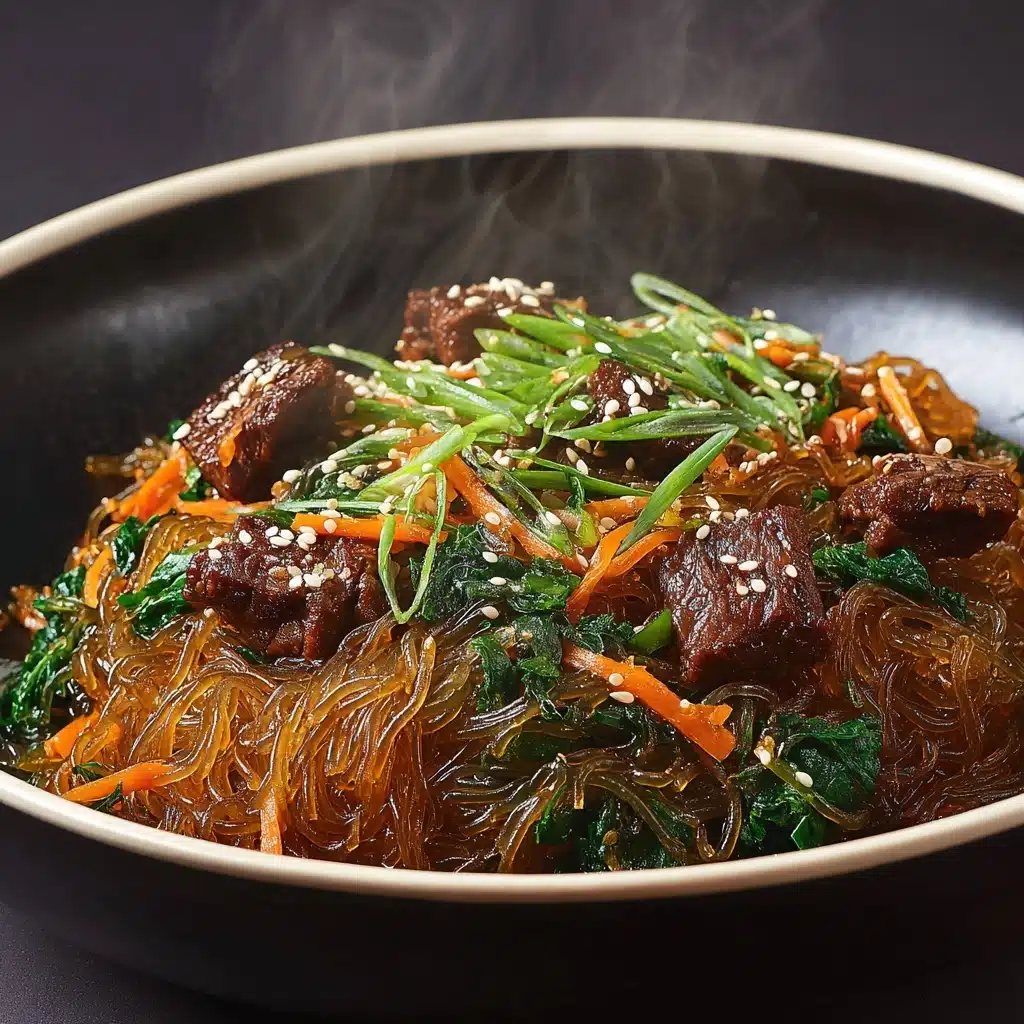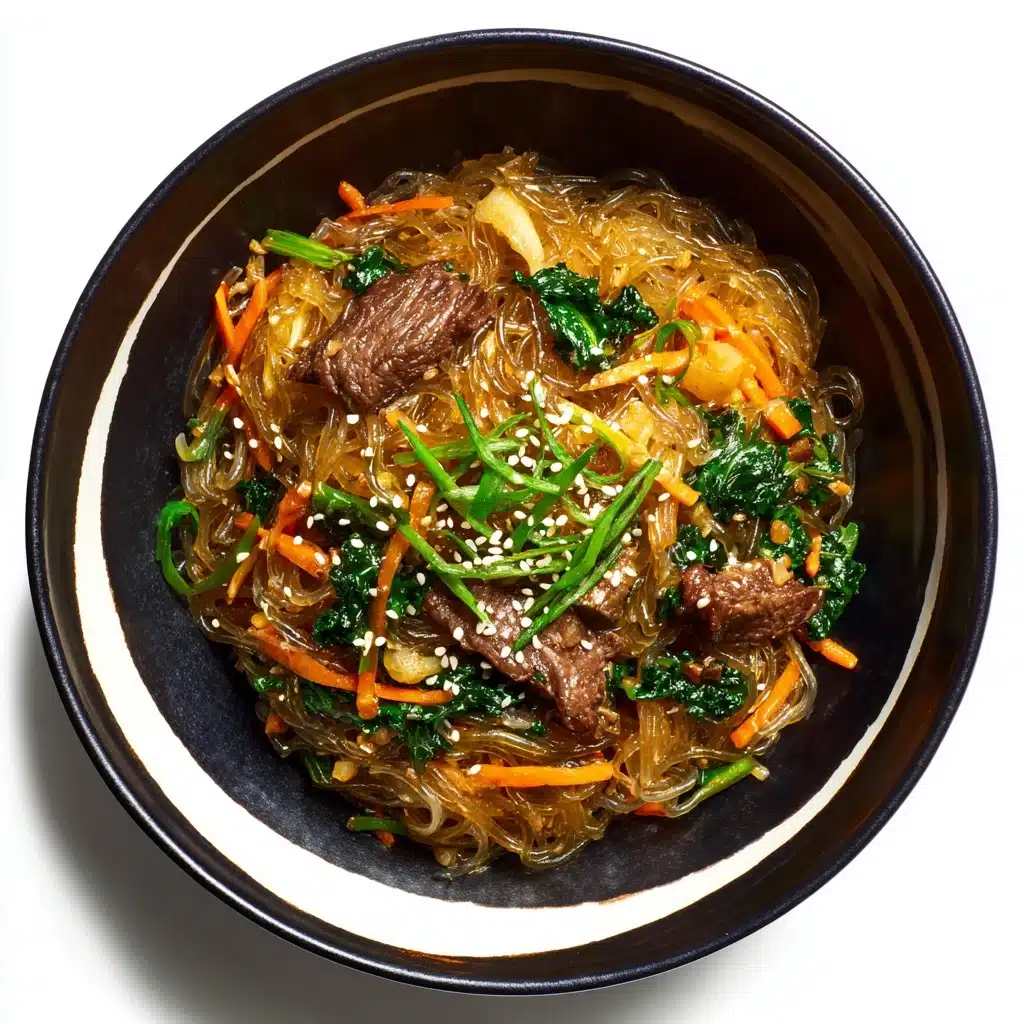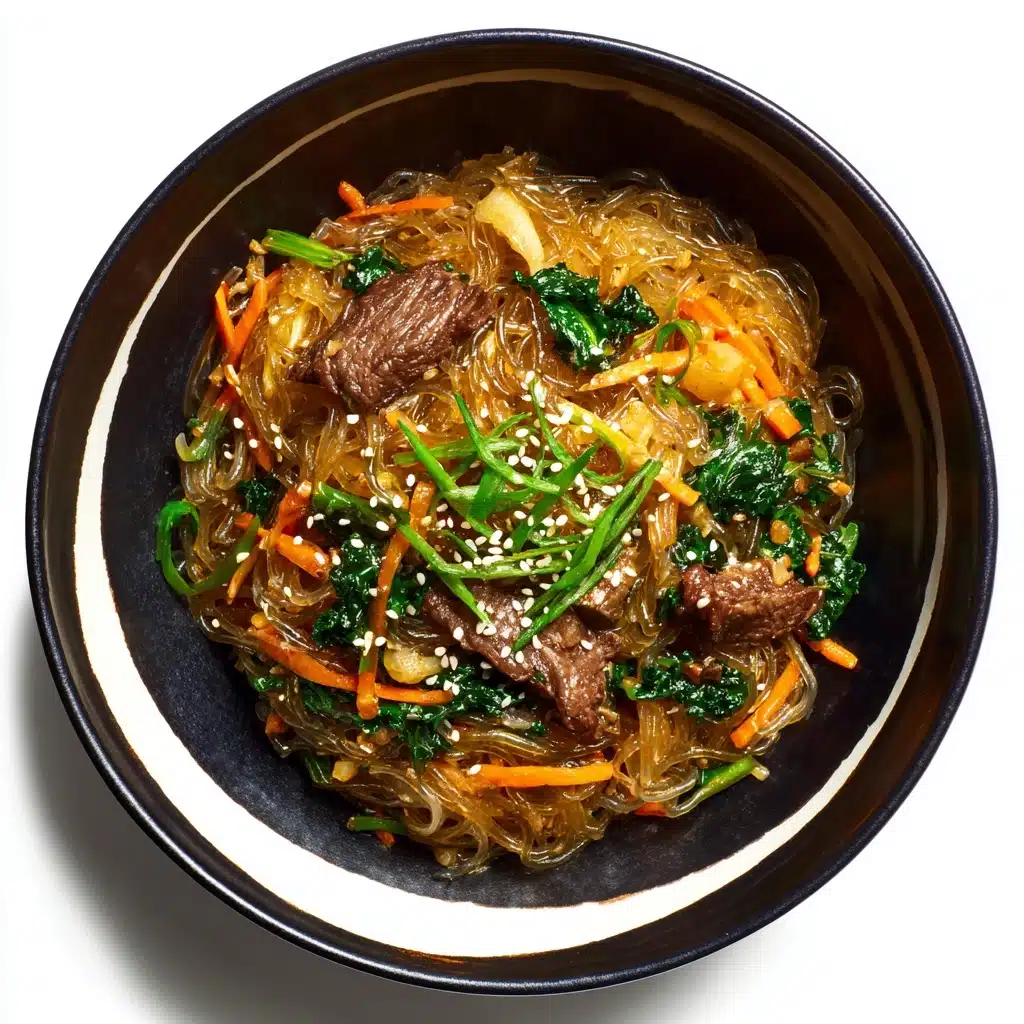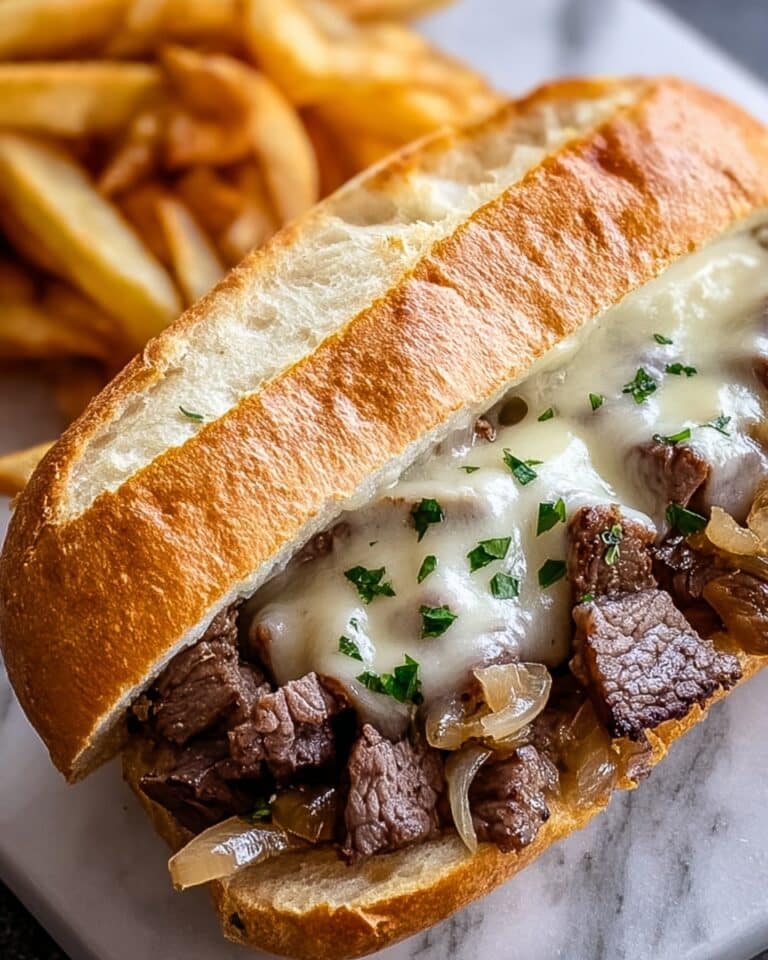There’s something truly magical about Japchae, the beloved Korean glass noodle stir-fry that strikes the perfect balance between sweet, savory, and utterly satisfying. With its glossy, chewy sweet potato noodles, vibrant vegetables, and toasty sesame aroma, Japchae is a dish that always delights at gatherings—or brightens up any weeknight dinner. Whether you’re new to Korean cooking or a longtime fan, this recipe is your ticket to experiencing Japchae’s irresistible flavors right at home.

Ingredients You’ll Need
Japchae’s beauty lies in its simplicity. Each ingredient is carefully chosen to create a dish that’s colorful, deeply flavorful, and full of textural contrast. Don’t be intimidated by the list—every component has a role, and once you gather them, you’re halfway to a fantastic meal!
- Sweet potato starch noodles (dangmyeon): These glass noodles are the heart of Japchae, offering a chewy, springy texture that soaks up all the delicious sauce.
- Sesame oil: Adds a nutty richness and signature aroma, both for tossing the noodles and finishing the dish.
- Soy sauce: Delivers deep umami and saltiness—feel free to use tamari for a gluten-free version.
- Sugar: Just a touch balances out the savory notes, giving Japchae its subtle sweetness.
- Vegetable oil: Keeps the veggies glistening and helps with the stir-fry process.
- Onion: Sliced thin, it brings gentle sweetness and rounds out the vegetable mix.
- Carrots: Cut into matchsticks, they add crunch and vibrant color.
- Red bell pepper: For a pop of sweetness and gorgeous red hue.
- Shiitake mushrooms: Earthy and meaty, they lend depth to the dish (fresh or rehydrated dried work equally well).
- Spinach: Wilts down beautifully, adding both nutrition and a lovely green freshness.
- Green onions: Their mild bite brightens up the whole stir-fry.
- Garlic: Minced and aromatic, essential for that classic Korean flavor punch.
- Toasted sesame seeds: Sprinkled on top, they add a subtle crunch and toasty finish.
- Salt and black pepper: For seasoning—taste and adjust as you go!
How to Make Japchae
Step 1: Prepare and Cook the Noodles
Start by bringing a large pot of water to a rolling boil. Drop in the sweet potato starch noodles and cook them according to the package instructions—usually about 6 to 7 minutes is all it takes for them to turn perfectly tender and delightfully chewy. Drain the noodles, rinse under cold water to stop the cooking, and toss them immediately with a tablespoon of sesame oil. This keeps them from sticking together and infuses the noodles with rich, nutty flavor right from the start.
Step 2: Mix the Sauce
While your noodles cool, whisk together soy sauce and sugar in a small bowl. Stir until the sugar is fully dissolved—this quick, two-ingredient sauce is the secret to Japchae’s signature sweet-salty balance. Set it aside; you’ll add it at just the right moment to bring all the flavors together.
Step 3: Stir-Fry the Vegetables
Heat your vegetable oil in a large skillet or wok over medium-high heat. Add the sliced onion, carrot, bell pepper, and shiitake mushrooms. Stir-fry for about 4 to 5 minutes, just until the veggies are tender-crisp but still vibrant. Next, toss in the spinach and cook for another minute—watch as it wilts down, turning bright green. Add the garlic and green onions, stirring for just 30 seconds to release their fragrance without burning.
Step 4: Combine Everything
Add the cooked noodles to your skillet, followed by the soy sauce mixture and the remaining sesame oil. Use tongs or two wooden spoons to toss everything together, making sure those glossy noodles are evenly coated and the vegetables are well distributed. Cook for another minute or two until everything is heated through, then taste and adjust with salt and black pepper as needed.
Step 5: Finish and Serve
Transfer your Japchae to a serving platter or individual bowls, and sprinkle generously with toasted sesame seeds. The dish is now ready to enjoy—warm, at room temperature, or even chilled, depending on your mood or the season!
How to Serve Japchae

Garnishes
Japchae shines with a final flourish of toasted sesame seeds, but you can also add a handful of thinly sliced green onions or even a few strips of nori for extra flair. For a little heat, a sprinkle of Korean red pepper flakes (gochugaru) is fantastic, too.
Side Dishes
This dish is wonderfully versatile—serve Japchae as a main with a simple bowl of rice, or let it play a starring role alongside other Korean banchan like kimchi, pickled radish, or pan-fried tofu. It’s also right at home next to grilled meats or a light soup for a more elaborate meal.
Creative Ways to Present
Elevate your Japchae by twirling it into neat nests on individual plates, or serve it in a big, family-style bowl for everyone to share. For parties, try filling lettuce cups with Japchae for a fun, handheld appetizer, or pack it into bento boxes for a colorful and delicious lunch.
Make Ahead and Storage
Storing Leftovers
Japchae keeps beautifully in the refrigerator. Simply transfer any leftovers to an airtight container and store for up to 3 days. The flavors will meld even more, making each bite even tastier the next day.
Freezing
While Japchae is best enjoyed fresh, you can freeze portions if needed. Place cooled Japchae in freezer-safe containers or bags, removing as much air as possible. Freeze for up to a month. When ready to eat, thaw overnight in the fridge for best texture.
Reheating
To reheat Japchae, gently warm it in a skillet over medium heat with a splash of water to loosen the noodles. Alternatively, microwave in short bursts, stirring in between. Add a drizzle of sesame oil or a dash of soy sauce if it needs a flavor boost.
FAQs
What makes Japchae noodles different from other noodles?
Japchae uses sweet potato starch noodles, which are naturally gluten-free and turn beautifully translucent and chewy when cooked. This unique texture is what sets Japchae apart from other noodle dishes and makes it so satisfying.
Can I add protein to Japchae?
Absolutely! You can stir in thinly sliced beef, chicken, or tofu for a heartier meal. Simply cook your protein of choice separately, then toss it in with the noodles and vegetables during the final mixing step.
Is Japchae served hot or cold?
The beauty of Japchae is that it can be enjoyed warm, at room temperature, or even chilled. It’s a popular party dish in Korea precisely because it tastes great at any temperature, making it perfect for make-ahead meals.
Can I use other vegetables in Japchae?
Yes! Japchae is wonderfully adaptable. Try adding zucchini, snap peas, or even broccoli florets—just slice everything thin so it cooks quickly and evenly. Use whatever looks freshest at the market.
How do I keep the noodles from sticking together?
The key is tossing the noodles with sesame oil right after draining and rinsing them. This not only keeps them from clumping but also infuses them with delicious flavor from the very beginning.
Final Thoughts
I can’t recommend trying Japchae enough—it’s colorful, deeply comforting, and packed with flavor. Whether you serve it for a holiday, a potluck, or just a cozy night in, every forkful is sure to win over new fans. Dive in, get creative with your veggies, and let Japchae become a new staple in your kitchen!
Print
Japchae Recipe
- Total Time: 35 minutes
- Yield: 4 servings 1x
- Diet: Vegetarian
Description
Japchae is a popular Korean dish featuring stir-fried sweet potato starch noodles combined with a colorful medley of vegetables like spinach, carrots, shiitake mushrooms, and bell peppers, all seasoned with soy sauce and toasted sesame oil. This light yet flavorful dish is perfect as a main course or side, served warm or at room temperature, offering a delightful balance of chewy noodles, fresh vegetables, and savory-sweet seasoning.
Ingredients
Noodles and Sauce
- 6 ounces sweet potato starch noodles (dangmyeon)
- 1 tablespoon soy sauce
- 1 tablespoon sugar
- 2 tablespoons sesame oil, divided
Vegetables and Aromatics
- 1 medium onion, thinly sliced
- 2 carrots, cut into matchsticks
- 1 red bell pepper, thinly sliced
- 4 ounces shiitake mushrooms, sliced
- 2 cups spinach
- 2 green onions, chopped
- 2 garlic cloves, minced
Cooking Oil and Garnish
- 1 tablespoon vegetable oil
- 1 tablespoon toasted sesame seeds
- Salt and black pepper to taste
Instructions
- Cook the Noodles: Bring a large pot of water to a boil and cook the sweet potato noodles according to the package directions, typically 6 to 7 minutes, until they become tender yet chewy. Drain the noodles and rinse under cold water to stop the cooking process, then toss them with 1 tablespoon of sesame oil to prevent sticking.
- Prepare the Sauce: In a small bowl, whisk together the soy sauce and sugar until the sugar completely dissolves, creating a balanced sweet and savory sauce.
- Stir-Fry Vegetables: Heat the vegetable oil in a large skillet or wok over medium-high heat. Add the sliced onion, carrot matchsticks, bell pepper, and sliced shiitake mushrooms. Stir-fry these vegetables for 4 to 5 minutes or until they are tender-crisp, maintaining their vibrant colors and some crunch.
- Add Spinach and Aromatics: Add the spinach to the skillet and cook for an additional minute, just until wilted. Then stir in the minced garlic and chopped green onions, cooking for another 30 seconds to release their fragrant flavors.
- Combine Noodles and Sauce: Add the cooked noodles to the skillet along with the soy sauce mixture and the remaining 1 tablespoon of sesame oil. Toss everything together thoroughly to ensure the noodles are well coated and the ingredients are evenly mixed and heated through.
- Season and Garnish: Taste the japchae and adjust the seasoning with salt and black pepper as needed. Finally, sprinkle the dish with toasted sesame seeds for an added nutty flavor and crunch before serving.
Notes
- Japchae can be enjoyed warm, at room temperature, or chilled, making it versatile for various serving preferences.
- For added protein, consider stirring in thinly sliced beef, chicken, or tofu during the vegetable stir-fry step.
- You can adjust the sweetness and saltiness by tweaking the ratio of soy sauce and sugar according to your taste.
- To make this dish gluten-free, substitute soy sauce with tamari.
- Do not overcook the noodles; they should remain slightly chewy for the best texture.
- Prep Time: 20 minutes
- Cook Time: 15 minutes
- Category: Main Course, Side Dish
- Method: Stir-Fry
- Cuisine: Korean
Nutrition
- Serving Size: 1 bowl
- Calories: 290
- Sugar: 6 g
- Sodium: 380 mg
- Fat: 10 g
- Saturated Fat: 1.5 g
- Unsaturated Fat: 8 g
- Trans Fat: 0 g
- Carbohydrates: 46 g
- Fiber: 3 g
- Protein: 5 g
- Cholesterol: 0 mg







